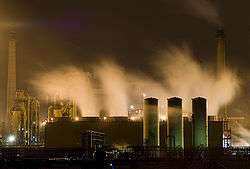Teesside Steelworks

Teesside Steelworks was a large steelworks located along the south bank of the River Tees between Middlesbrough and Redcar in the unitary authority area of Redcar and Cleveland in the ceremonial county of North Yorkshire, England. Located near the mouth of the River Tees close to the river's outfall into the North Sea, the site's blast furnace was the second largest in Europe.[1]
The majority of the steelworks, including the Redcar blast furnace, Redcar and South Bank coke ovens and the BOS plant at Lackenby closed in 2015. The Teesside Beam Mill and some support services still operate at the Lackenby part of the site.
History
Founded by Dorman Long in 1917, the steel produced was used to build structures including the Sydney Harbour Bridge, Tyne Bridge and the Auckland Harbour Bridge.
In 1967 Dorman Long was absorbed into the newly created nationalised company, British Steel Corporation. After privatisation in 1988 to form British Steel plc, in 1999 the company merged with Netherlands-based steel maker Koninklijke Hoogovens to form Corus Group. Corus utilised the site for basic oxygen steelmaking, using iron produced at the company's Redcar blast furnace. In 2007, Corus was bought by Tata Steel.[2]
SSI: 2012–2015
In light of the termination of a large contract in 2009, Tata stopped production and 1,700 jobs were lost at the plant.[3]
On 24 February 2011, the steelworks was purchased by Thai-based Sahaviriya Steel Industries (SSI).[4] On 15 April 2012 the plant was officially reopened.[5] On 18 September 2015, production was paused due to the decline in steel prices.[6] On 28 September 2015, the plant was "mothballed" amid poor steel trading conditions across the world and a drop in steel prices.[7] On 2 October, the owner of the site, SSI UK, entered liquidation. On 12 October 2015 the receiver announced there was no realistic prospect of finding a buyer and the coke ovens would be extinguished.[8]
British Steel: 2016–present
The remainder of the site still operational (Teesside Beam Mill and ancillary support services at Lackenby), was sold by Tata Steel to investment firm Greybull Capital on 1 June 2016. As part of the deal, the historic British Steel name was resurrected. The new company includes the UK sites of Skinningrove and Scunthorpe as well as the Hayange rail plant in northern France.[9][10]
Transport
The site is situated alongside the A66 and A1085 dual carriageways. Main access is via the Lackenby and Redcar entrances, situated on the A1085.
The site is adjacent to Teesport that was used for iron ore, coal, and other raw material imports, and steel exports.
The site is served by the British Steel Redcar railway station, which opened on 19 June 1978.[11] There is no public access to and from the station (being located on private land), it has a very limited service provided by Northern.
References
| Wikimedia Commons has media related to Redcar steelworks. |
- ↑ "Workers return as steelworks furnace is relit". BBC News – Business. BBC. 15 April 2012. Retrieved 17 April 2012.
- ↑ "Teesside Steelworks For Sale". BBC News. BBC. 26 January 2009. Retrieved 5 May 2009.
- ↑ "2,000 face redundancy at English steelworks". Wikinews. 9 May 2009. Retrieved 9 May 2009.
- ↑ "Teesside steel plant's £291m sale secures 700 jobs". BBC News Online. BBC. 24 February 2011. Retrieved 25 February 2011.
- ↑ "Blast furnace at former Corus Redcar steel plant relit". BBC News Online. BBC. 15 April 2012. Retrieved 15 April 2012.
- ↑ "SSI Redcar steel plant production 'paused'". BBC News. BBC. 18 September 2015. Retrieved 18 September 2015.
- ↑ "SSI Redcar steel plant mothballed, costing 1,700 jobs". BBC News. BBC. 28 September 2015. Retrieved 28 September 2015.
- ↑ "SSI Redcar steelworks to be shut". BBC News. BBC. 12 October 2015. Retrieved 12 October 2015.
- ↑ "British Steel name back on Teesside as Greybull completes £400m deal to buy Tata Long Products sites". Middlesbrough Gazette Live. Retrieved 11 June 2016.
- ↑ www.railwaygazette.com 2nd June 2016: British Steel brand revived
- ↑ Butt, R.V.J. (1995). The Directory of Railway Stations. Yeovil: Patrick Stephens Ltd. p. 44. ISBN 1-85260-508-1. R508.
Coordinates: 54°35′33″N 1°08′07″W / 54.5924°N 1.1352°W